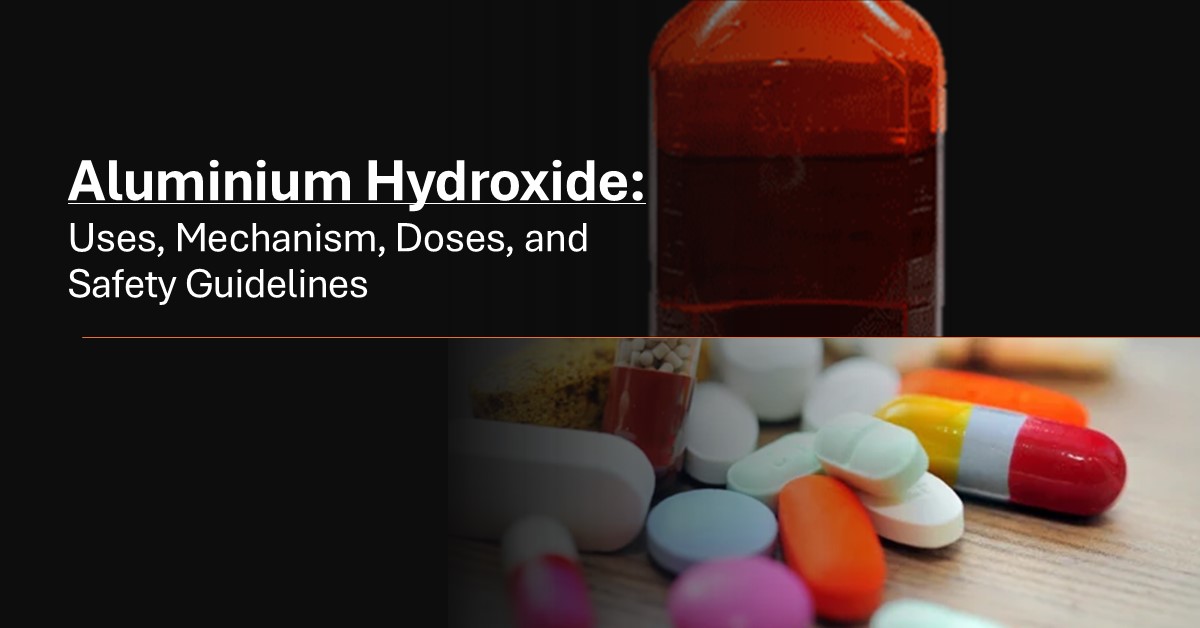Introduction about Aluminium Hydroxide:
It reacts with HCL to form Aluminium chloride and water.
Aluminium hydroxide is an antacid commonly used to relieve heartburn, acid indigestion, and upset stomach. It works by neutralizing excess stomach acid, forming a protective layer on the stomach lining. Beyond its antacid role, it also serves as a phosphate binder in patients with chronic kidney disease (CKD). Widely available in tablet, liquid, and powder forms, aluminium hydroxide is a key component of many over-the-counter medications.
Indications:
Aluminium hydroxide is indicated for:
- Relief of symptoms associated with hyperacidity, such as heartburn and acid reflux.
- Managing peptic ulcers by neutralizing gastric acid.
- Treatment of gastroesophageal reflux disease (GERD).
- Acting as a phosphate binder in CKD patients to manage hyperphosphatemia.
Mechanism of Action:
Aluminium hydroxide works through the following mechanisms:
- Acid Neutralization: It reacts with hydrochloric acid (HCl) in the stomach, reducing acidity and relieving symptoms like heartburn.
- Phosphate Binding: In the gastrointestinal tract, it binds to dietary phosphate, forming insoluble aluminium phosphate, which is excreted in the stool. This mechanism helps reduce phosphate levels in CKD patients.
- Protective Effect: The neutralization of acid can protect the stomach lining from further irritation caused by excess acid.
Adverse Effects:
While generally safe, aluminium hydroxide can cause side effects, especially with prolonged use:
- Common Side Effects: Constipation, bloating, and nausea.
- Rare but Serious Effects: Hypophosphatemia due to excessive phosphate binding, osteomalacia, and aluminum toxicity (in cases of chronic overuse or renal impairment).
- Allergic Reactions: Rash, itching, or swelling in rare cases.
Preparation:
Aluminium hydroxide is available in various pharmaceutical formulations, including:
- Suspensions: Ideal for patients who have difficulty swallowing tablets.
- Tablets: Often combined with magnesium hydroxide for balanced effects.
- Powder: Can be reconstituted for oral use.
Manufacturing Notes:
- Prepared by precipitation from an aqueous solution of aluminium salts, followed by drying and milling.
- Purity and particle size are critical for efficacy and safety.
Doses:
The dosage of aluminium hydroxide varies based on the indication and patient-specific factors:
- Antacid Use: 500 mg to 1.5 g taken orally, 3-4 times a day, preferably after meals and at bedtime.
- Phosphate Binding in CKD: 500 mg taken with meals, adjusted based on serum phosphate levels.
- Pediatric Use: Doses should be adjusted according to body weight, under medical supervision.
Contraindications:
Aluminium hydroxide should not be used in the following cases:
- Patients with hypersensitivity to aluminium compounds.
- Severe renal impairment due to the risk of aluminium accumulation and toxicity.
- Conditions like hypophosphatemia where phosphate levels are already low.
- Chronic constipation, as the medication can exacerbate symptoms.
A Note from Medical and Health Hub:
If you have questions about aluminium hydroxide or its use, consult a healthcare professional. Always follow the prescribed dosage and report any unusual symptoms promptly.
Aluminium hydroxide remains a cornerstone in managing hyperacidity and hyperphosphatemia. When used responsibly, it offers effective relief with minimal risks. Staying informed about its uses, dosages, and potential side effects is key to safe and effective treatment.
Frequently Asked Questions (FAQs):
What is aluminium hydroxide used for?
- It is used to relieve heartburn, acid indigestion, and manage hyperphosphatemia in CKD patients.
Can aluminium hydroxide cause constipation?
- Yes, constipation is a common side effect, especially with prolonged use.
Is aluminium hydroxide safe during pregnancy?
- It is generally considered safe but should be used under medical advice.
How does aluminium hydroxide reduce phosphate levels?
- It binds to dietary phosphate in the gastrointestinal tract, forming insoluble complexes excreted in the stool.
Can I take aluminium hydroxide with other medications?
- Caution is advised, as it may interact with drugs like tetracyclines or iron supplements. Space doses to avoid interactions.


